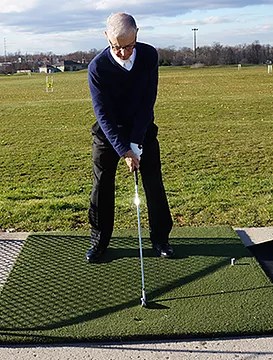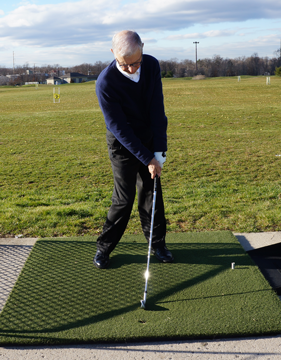The Starting Position has the right shoulder lower than the left, the right elbow bent, and the hands in the middle of the body.

Instruction


The Impact Position is delivering the shaft before the club face as a result of a bent right wrist, flat left wrist, a bent right elbow or a right shoulder going down and out to the ball. One of those four allow the other three to occur.
The grip is most important because it connects the hands to the golf club. Even though, at times, you may think the ball has a mind of its own, in reality the ball will only do what the clubface tells it to do. The grip is a communication device that gives directions to the clubface. I recommend the overlap grip for most golfers.
Place the golf club under the heel pad of your left hand, across the first joint of the left index finger. This will permit the left wrist to hinge up and down, the way it is intended.

Next, the grip is held by the middle fingers of the right hand, at the lowest joint, near the callus pad of your hand, just under the golf club’s grip.
The thumb pad of the left had in placed on the top of the golf club, to the right of the grip and held in the fingers of the left hand.

The right palm lifeline covers the first joint and nail of the thumb of the left hand. The thumb of the right hand is placed just left of the golf club’s centerline. The index finger of the right hand is curled around the club grip and the pinky overlaps the index finger of the left hand.
The overlap grip aids in unifying the hands so they function as a single unit.

This demonstrates the overlap grip. Note the gap between the index and middle fingers of the right hand. This will allow the right elbow to hinge during the back swing.


STARTING POSITION & THE START OF THE SWING
The tailbone is up and out, the shoulders are over the toes, and the weight is on the balls of the feet. This is the braced position needed, to create your athletic golf swing. The aim of the body is always on the inside of the target line. The upper body starts the golf swing.

ON PLANE POSITION
At this point the shaft of the golf club is pointing at the target line, this is called the shaft plane. The shaft plane is created by the rotation of the upper body around the spine angle, this directs the hanging arms to the shaft plane.

BACK SWING POSITION
The continued rotation around the angle of the spine places the left arm parallel of the shoulder place which is pointing at the baseline.

DOWNSWING PLANE
The shaft returns on plane, due to the rotation around the spine angle created at the starting position.

IMPACT PLANE – THE MOMENT OF TRUTH
The golf ball is being compressed on the inside corner down into the EARTH. The ball is on it’s way to the target, as a result of the body rotating around the target line on the original spine angle. This is the moment of explosion to the target distance, not direction.

POST IMPACT
Let the eyes follow the ball to the target.

SHAFT ON SHOULDER PLANE
Notice that the shaft of the club is still on it’s plane, and parallel to the shoulder angle. Again, a result of continuous rotation.

FINISH IN BALANCE
A full balanced position will occur as a result of rotation, leaving 90% of the weight on the left heel.
Next, the grip is held by the middle fingers of the right hand, at the lowest joint, near the callus pad of your hand, just under the golf club’s grip.
The thumb pad of the left had in placed on the top of the golf club, to the right of the grip and held in the fingers of the left hand.
The right shoulder is lower than the left. The ball is placed inside the right heel, the hands are inside the left hip.

The triangle of the shoulders and arms are being moved by the back.

The shaft of the club is on the body lines left of the target. The eyes are following the ball to it’s target.

The feet are at a 45 degree angle left of the target line, the shoulders are 30 degrees left of the target line.

The triangle of the arms and shoulders are being moved by the back.

The shaft is traveling on the path of the body lines.

The keys to successful putting and strokes off your score are:
- balance,
- touch
- hand-eye coordination.
Putting begins with a message transmitted to the brain through the eyes. When the eyes are over the ball, a signal is sent to the brain and the inner ear for interpretation. Balance and hand-eye coordination are achieved as a result of this messaging system.
Putting control comes from balance, when you are balanced over the ball you can maintain a proper putting stroke throughout.
Distance control is a result of the ball striking the center of the putter face. The smallest stroke possible with the center of the putter face striking the ball is all that is generally required. The shoulders and arms do all the work, one motion, one speed.
What affects the roll of the ball is: texture of the green, the roundness of the ball (not all balls are perfectly round), and swing speed on the putter.
The club is held in the palm of the left hand with the thumb on the top of the shaft.

The grip of the putter is held in the palm of the right hand. The thumb is on top of the shaft.

The palms face each other, the thumbs are on top of the shaft.


Feet, shoulders, hips, and eyes are all parallel to the roll line.

The back is moving the triangle of the front, this alows the shaft of the club to swing on it’s design. The head remains in it’s space.

The head remains still, for a count of three. The left wrist is flat.
The bridge of the nose is over the ball. Feet, shoulders, and eyes are all paralell to the target line.

The face of the club swings on it’s design, due to the triangle being moved by the back. The triangle is formed by the shoulders and arms.

The bridge of the nose is over the roll line. The feet, shoulders, and eyes are all parallel to the roll line.

Holding the club in the right hand, rotate the club face to the right (this is called open).

Place the left hand on the club, and set your grip along with your right hand.

Angle your body to the left of the target you have chosen. This will allow the player to swing on the path of the body.

Notice that the bottom of the club head has struck the sand carrying it out towards the target.

The arms continue to travel on the path of the body alignment.





